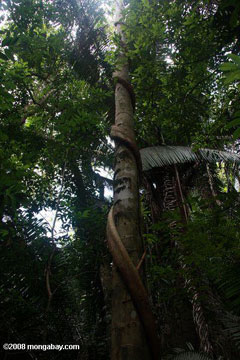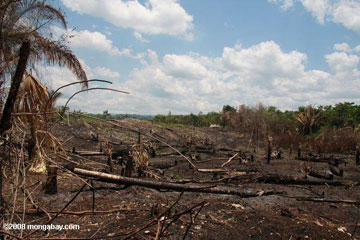One-fifth of the Brazilian Amazon’s tree species to go extinct, even under optimistic scenario
20% of the Brazilian Amazon’s tree species to go extinct
Jeremy Hance, mongabay.com
August 11, 2008
A new study estimates the number of trees that will go extinct in the Brazilian Amazon due to habitat loss.
The research, published in the early edition of the Proceedings of the National Academy of Sciences (PNAS), suggests that under optimistic scenarios, 20 percent of tree species will disappear. In a bleaker scenario, 33 percent will go extinct. If this proves true, Amazonian trees may be in as much danger as coral reefs and amphibians, both of which face extinction crises.
Although, no one knows the actual number of tree species in the Brazilian Amazon, the authors, led by Stephen P. Hubbell of the University of California at Los Angeles, used various mathematical theories to estimate the number of species at just over 11,200, including 5,308 rare species with less than 10,000 surviving individuals. Predicted extinction rates for these rare species are high, ranging from 37-50 percent.
 Photo by Rhett A. Butler |
“On the one hand, under all of the scenarios we considered, a large number of very common tree species will almost certainly survive habitat losses, whether one takes an optimistic or nonoptimistic view of deforestation in the Brazilian Amazon. This is the good news,” write the paper’s authors. “The bad news is that large percentages of rare and endemic species will probably go extinct.” They authors believe that continual habitat loss could result in hundreds to several thousand rare species disappearing forever from Amazonia.
The researchers insist that any forecast suffers from several unknowns — most notably a lack of data — across an immense study area. Further the authors took into account only habitat loss in relation to extinction. They acknowledge that biological interdependence may result in more extinction, for example if a bat pollinator goes extinct how will that ripple through the tree species it aided in pollination, the same goes for insects, birds, and mammals.
The best way, the authors argue, to have most accurate descriptions of species loss in the coming decades is with more research.
 Photo by Rhett A. Butler |
“Although it is an old scientific chestnut,” they write, “we must once again emphasize how important it is to support continuing basic science on tropical forests. We urgently need information on the biogeography, population sizes, comparative life histories, and environmental requirements of tropical tree species.”
Such information may be the Amazon’s most important conservation tool.
Stephen P. Hubbell, Fangliang He, Richard Condit, Luís Borda-de-Agua, James Kellner, and Hans ter Steege (2008). How many tree species are there in the Amazon and how many of them will go extinct? PNAS Online Early Edition for the week of August 11-15, 2008.














